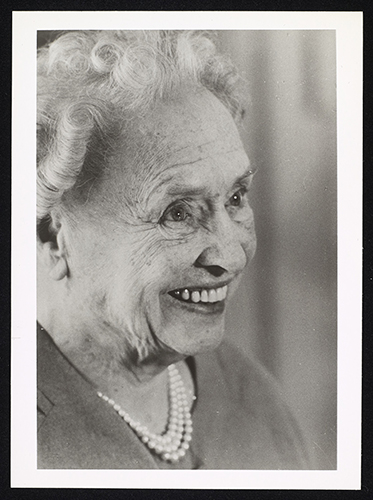Head and shoulders image of Helen Keller taken at her 80th birthday in 1960.
Helen Keller died 50 years ago today – just a few weeks short of her 88th birthday. As the archivist and caretaker of her collection, I initially wondered how I nearly overlooked this anniversary. Upon consideration, I have several theories about this that I’d like to share with you.
In the decade and a half of my professional role, I have never focused on her death date. Keller was fortunate enough to live a long life and she had the joy of witnessing the inroads she made to improve the lives of those with vision loss. But it's good to reflect on how far, or how far off we are in realizing Keller’s goal of equal rights for people with disabilities. Laws passed during her lifetime providing accommodations for those with vision loss still stand. And the progress continued; the Americans with Disabilities Act (ADA) was passed in 1990 and even beyond legislation, perceptions of vision loss have changed.
However, a great deal remains to be done. On her 80th birthday in 1960, Keller was interviewed by Ann Carnahan. Carnahan asked her the following "What is your greatest personal wish?" Keller replied, "I would love to see the day when every blind child has an opportunity of an education and every blind grown-up has the chance for training and job placement." AFB continues to fight for education and employment rights to this day.
Another reason that I have never focused on the anniversary of her death, is that I always celebrate Helen Keller’s birthday in some shape or form, so I’ve been busily preparing for her 138th birthday on June 27th. This year I think she’d be thrilled, as this month marks the official launch of the digital Helen Keller Archive. The American Foundation for the Blind’s month-long June 2018 celebration focuses on the pioneering technology of the digital collection and the treasure trove of information it contains. We believe that the online archive is the most accessible archival collection currently available. This means that visitors who are blind, deaf, hard-of-hearing, and deafblind can navigate the website. A sighted visitor cannot tell that the site is different from any other website just by looking at the screen, as it is the back end of the system—the coding of the customized software—that enables visitors with disabilities to navigate the site with their own assistive technologies.
We are celebrating this landmark achievement of a fully accessible historical collection with blog posts throughout the month of June. These posts were written by archivists, scholars, a writer, film maker, and a leader in the field of accessible technology—so stay tuned!
And then there’s the pizza party at the New York Institute for Special Education in the Bronx! In preparation for my visit, 5th and 6th graders with visual impairments have been studying Helen Keller and learning how to navigate a digital archive. During my visit, we’ll talk more about Helen and we will continue to dig around the site. And of course, there will be candles to blow out!
And then there’s the new grant we’ve just received from the National Endowment for the Humanities (NEH). Due to the generosity of the NEH, over 163,000 digital images are currently available on the web site. This additional funding is allowing us to digitize and create metadata for the press clippings and scrapbooks contained in Keller’s archive. These materials, closed to the public due to their fragility, can provide information unavailable in other parts of the collection.
I hope that you’re getting the picture! Helen Keller is a living presence for me. Her unique archive is a constant reminder of the power and importance of persistence and resistance. It is up to us to learn from her life and advocate for the things we believe in.
We hope you enjoy exploring the Helen Keller Archive yourself!
